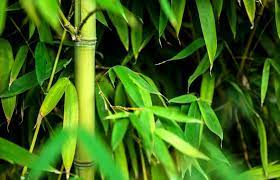

By Titilayo kupoliyi
The versatile bamboo leaves are from the Poaceae grass family, found in tropical and subtropical areas, especially in the monsoon and wet tropics.
The grass grows as tall as 40 meters and offers a host of vitamins and minerals.
Yoruba called it Ewe Oparun, Bishiyar Bamboo in Hausa and Igbo call it Atosi.
People living in Japan, Taiwan, India, China and Southeast and South Asia dine on bamboo, adding cooked bamboo shoots to salad and other recipes.
Bamboo is packed with vitamins and essential minerals such as niacin, vitamin A, vitamin B6, and vitamin E, which is the body’s most powerful antioxidant.
It is known to naturally enhance collagen production, help to detox the body, and boost natural immunity.
There are a myriad of bamboo leaves benefits that range from physical benefits to soil support to household benefits.
You may have seen bamboo furniture, household decorations and healthy food that are taken in as vitamins, minerals and vegetables.
Yet, the first image that might pop into your mind when you hear the term “bamboo leaf” is those giant, cuddly looking red pandas that frolic in mountains in the South Central part of China.
Madagascar’s lemurs love eating bamboo leaves too. But, what’s the big attraction? What are the benefits of bamboo that you might be missing out on?
Bamboo leaves also served as the panda’s primary food source, helping to keep pandas from extinction centuries ago.
To get the most of the bamboo leaves benefits, it is important to ensure that bamboo leaves are properly cleaned, cooked and prepared.
Among the bamboo properties are the stem, the stem base, the stem petiole, sheath, blade, culm, node and bamboo shoots.
The shoots and bamboo leaves are the edible part of bamboo. This is how to likely get bamboo leaves benefits. Knowing how to separate the shoots and leaves from other parts of the plant is another fact to be familiar with. If the plant is grown in mass, pulling the edible parts of bamboo away from the stem could take time; creating a delay as it regards getting bamboo leaves benefits.
Just as people do in Asia, you can dine on bamboo leaves, eating them like vegetables by using Herbal Goodness bamboo leaves in salads. You can also gain bamboo leaves benefits from drinking bamboo leaf tea, a drink that offers a mild, sweet taste. Cook the shoots and you can acquire a texture similar to asparagus. It is no wonder that bamboo leaves benefits and bamboo leaf menu items are popular in different parts of the world.
The United States Department of Energy’s Office of Science shares that bamboo leaf extract is known for its antioxidants.
Additionally, bamboo leaves benefits may include antibacterial activity. Amino acid, potassium, calcium, magnesium, copper, iron, zinc and phosphorous are minerals and other benefits found in plants from the Poaceae grass family.
Other bamboo leaves benefits include vitamin E, vitamin B6, vitamin A, niacin and thiamine. As a plant high in protein, bamboo leaves and bamboo shoots may have a positive effect on metabolism.
Report shows that some women in India consume edible parts of bamboo that has been safely prepared as a way to balance an irregular menstrual cycle.
As many as 17 amino acids have been found in bamboo shoots. Fortunately, this is one of the edible parts of the plant. If you’re physically active, going to the gym three or more days a week or if you run, bike ride or swim each day, amino acids may be a good protein supplement. And, this brings up another of the bamboo leaves benefits.
Bamboo shoots offer protein. Even more, you can take in protein even after cooking bamboo shoots for 15 to 20 minutes. Fiber and carbohydrates are other bamboo leaves benefits. If you’re a long distance runner or if you ran middle and long distance track in high school or college, you know the role that carbohydrates play in fueling your body.
An extra benefit is that bamboo shoots and bamboo leaves are low in calories. In fact, a cup of bamboo shoots can have less than 50 calories. Of course, as with other plants, the actual calories in a bamboo leaf menu depends on how you prepare the plant. For instance, you could add soy sauce, chicken broth, ground pork, baked chicken and sesame oil to bamboo shoots or bamboo leaves, increasing caloric intake.
One of the biggest benefit is it promotes hair growth. If you are losing hair, have a cup of bamboo tea daily and watch the amazing results.
Bamboo contains about 70% silica, which is the highest in any plant. It is this silica that benefits skin, nails, and hair tremendously by encouraging the production of collagen, one of the essential proteins needed for maintaining the youthfulness of skin and tissues.
Uses of bamboo are not new. This fantastic plant is been used since centuries. Just like coconut, almost all parts of bamboo plant can be utilized. The edible part is bamboo shoot.
Although, bamboo leaves are inedible, the leaves can be crushed and processed and used for making tea. Bamboo tea bags are readily available in the market.
In summary health benefits of bamboo leaves are:
- It aids in digestion.
- The high silica content helps to alleviate diarrhea and bloating.
- If you are suffering from the problem of flatulence, have a cup of bamboo tea daily for a few days.
- Bamboo leaf tea is one of the most effective remedies to fight hair loss.
- It can also improve condition of skin and impart it a healthier glow.
- Silica is an essential trace mineral required for increasing flexibility and strength of connective tissues in the body, including bones and cartilage. A cup of bamboo leaf tea daily can do wonders to you.
Sciencedirect.com
Subscribe to our Telegram and YouTube Channels also join our Whatsapp Update Group